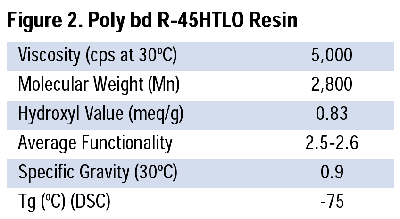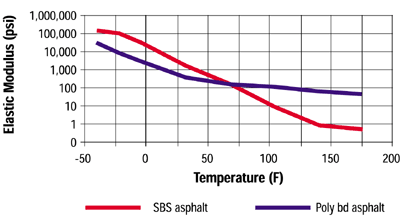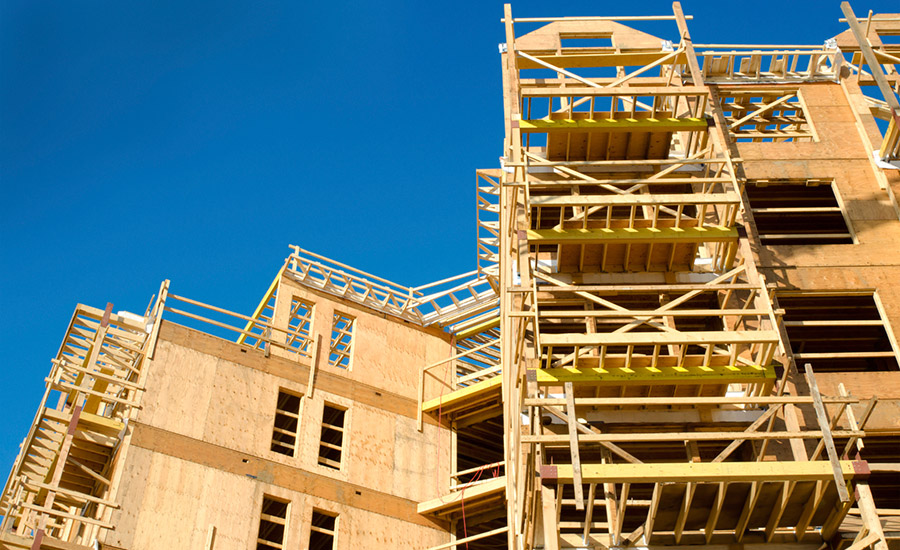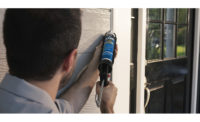
Poly bd® resins, from Elf Atochem North America Inc., Philadelphia, are liquid, hydroxyl-terminated homopolymers of butadiene. The facile reaction of Poly bd resins with curing agents such as conventional di- and polyisocyanates provides an economical route to the preparation of general-purpose elastomers. The unique structure of these resins provides properties that surpass conventional polyether and polyester urethane systems, as well as conventional, general-purpose rubbers. Moreover, the unique compatibility of Poly bd R-45HTLO resin with asphalt allows formulators to make a new variety of polymer—modified asphalt systems, according to Romuald de Haut de Sigy, general manager, Functional Polymers.

Applications
Poly bd resins are used in adhesives, sealants, castable elastomers, caulks, membranes, foams, coatings, propellant binders, potting and encapsulating compounds, as well as other rubber-fabricated materials. In the construction arena, these resins are used in many different applications worldwide. These include:
- Penetration joints and adhesives for EPDM or asphalt roofing membranes
- Adhesives and sealants, crack-filling or expansion joints for roofs, road and bridge applications, and airports
- Self-adhering systems (tapes or pressure-sensitive adhesives, with or without asphalt)
- Self-leveling waterproof and sound-deadening adhesives layer between floors in buildings, as well as basement joints
- Waterproof membrane or geomembrane for parking, roof decks and terraces; waste water, potable water (NSF 61 approved), paper mills and sewage pipes; and below-grade waterproofing
- Tank and pipe coatings
- Intumescent formulations
- Dynamic insulation for under-the-rail applications
Good Characteristics for Construction
Due to the molecular structure of Poly bd resins, the resulting urethane system exhibits some unique characteristics that are valued in the construction market.

Hydrolytic Stability
The hydrophobic backbone of Poly bd resins imparts excellent hydrolytic stability to the finished product, surpassing that of any other type of polyurethane. Poly bd resin-based urethane systems exhibit a low water-absorption rate, even in boiling water. The moisture-vapor transmission rate (MVTR) is lower than conventional products, and some systems can even cure underwater with no change in the final characteristics. However, a dry substrate is required to get a strong adhesion.
For example, a simple, two-component polyurethane formulation based on Poly bd R-45HTLO resin cured with a polymeric MDI (diphenylmethane diisocyanate) will have less than 0.01% weight uptake after being immersed in water during one day at room temperature, less than 0.20% when immersed two hours in boiling water, and will exhibit a Water Vapor Permeance of 0.005 g/m2.h.mmHg (1.65 mm thickness).
Figure 3 describes MVTR values determined according to the standard ASTM E96 (38ºC/90%RH) for a non-filled and asphalt-filled polyurethane.
Low-Temperature Flexibility
Polyurethane elastomers based on Poly bd resins also exhibit outstanding low-temperature properties. This characteristic is attributable to the “rubbery” polybutadiene backbone. Many polyurethane elastomers derived from Poly bd resins will have brittle points as low as -70ºC (-94ºF). [Note: Since Poly bd resin is compatible with asphalt and process oils, the brittle point will change accordingly to the formulation, but if the miscibility is good, the final product will have just one brittle point, indicating that the products are compatible. So, the brittle point of a formulation highly filled with asphalt and process oils could be, for example, around -40ºC (-40ºF).]
This property is very important, especially for joint-sealant applications, or crack bridging for the membrane applications, according to Maxime Deroch, technical development manager for Poly bd resins. When the temperature is low, the joint’s gap or the crack is larger because of the coefficient of thermal expansion (CTE) of the substrate, and a product with an excellent elongation at break at low temperature is required. Because of the butadiene backbone and the urethane network, the final product has a good elasticity and a good elastic return, and therefore a good resistance to temperature cycles.
Chemical Resistance
Polyurethane elastomers based on Poly bd resins exhibit excellent resistance to aqueous inorganic acids and bases. This characteristic, which is attributable to the hydrophobic nature of the polybutadiene backbone, is especially beneficial in making sealants and membranes for potable-water storage, waste water recycling, or tank and pipe sealants and coatings for the mining industry. Moreover, Poly bd resin-based polyurethane elastomers have outstanding resistance to salt water.
Poly bd resins are highly hydrophobic, but are compatible with oils and greases. Like asphalt itself, when immersed in such a media, the polyurethane formulation will absorb the oily materials. But unlike asphalt or even SBS-modified asphalts, which will literally dissolve in the oily products, the polyurethane-crosslinked backbone will prevent the product from swelling, and the oily contaminant will leave the product as fast as it entered it, with no major change in the mechanical properties afterwards. The network is not destroyed. This characteristic can allow, for example, the use of a polyurethane based on Poly bd as a sealant at airports.
Adhesion
Once again, due to the non-polar backbone of the Poly bd resin, the polyurethane usually exhibits good adhesion to various substrates, such as concrete, wood, metallic surfaces, glass and cement. Poly bd resin has a low surface tension (36.7 mN/m), and therefore shows good wetting on the substrates (even in a formulation without solvent), a condition which is necessary to achieve good adhesion.
Compatibility with Asphalt and Process Oils
Poly bd resins, because of their hydrocarbon backbones, are compatible with conventional hydrocarbon oils, chlorinated oils, asphalts and other related low-cost materials. Such mixtures can be cured with conventional diisocyanates to yield oil-extended elastomers.
Process oils are generally used as plasticizers to reduce the viscosity, hardness and cost of the system and usually increase the elongation at break.
Asphalts are compatible with Poly bd R-45HTLO resin (and less compatible with Poly bd R-20LM, which is slightly more polar). The Poly bd resin network can accept large quantities of fillers and asphalt. The asphalt used needs to have as low a moisture content as possible because of the reaction between water and the isocyanates. The addition of molecular sieves to the formulation is recommended to avoid this problem. A comparison between a SBS-modified asphalt and a Poly bd resin urethane-modified asphalt shows significant differences.
An SBS-modified asphalt is a one-component system that needs to be heated at a high temperature to be applied. This step takes time and consumes a lot of energy and equipment on-site. Alternatively, the system can be applied at room temperature when extended with solvent. However solvent evaporation will take a very long time, especially if the thickness is high. The final product is very thermosensitive, which means that it will become brittle at low temperatures and the modulus will dramatically decrease at high temperatures. In addition, because the elastic return is not good, poor rut resistance will result, and the product will essentially dissolve when in contact with fuel or oily products.
An asphalt-modified polyurethane based on Poly bd resins is totally different. Before curing, the system is usually a two-component system (Poly bd resin + asphalt + process oil + filler + additives on one side, and polyisocyanate + asphalt, process oil or filler on the other side), which is liquid at room temperature (cold-applied system), so there is no need to heat the product before use.
After cure (the cure time can be adjusted with catalyst), the final product is a thermoset. This means that there is a real network, and the final product is a modified polyurethane with a good elastic return and no swelling, even at high temperatures such as 120°C. The product will not return to a liquid phase, even if it is heated. Furthermore, elongation at break will remain the same or even increase at temperatures as low as -30ºC, a very desirable feature. The resistance to thermal shock is then improved, as well. Finally, the system will be very hydrophobic, with good resistance to aqueous acids and bases. When exposed to an oily product, there will be a weight increase but the network will not be destroyed, and the light oils should leave the product as fast as they entered it, without dramatically modifying the system’s mechanical properties. Most of the asphalt-extended formulations can cure underwater. One of the most interesting characteristics of this system when compared with an SBS-modified asphalt is the rut resistance, since this system is a thermoset that will not swell.
High Filler Acceptance
Poly bd resins are well known for their ability to accept large amounts of fillers without significant adverse changes in the final product. Most common fillers, such as calcium carbonate, silica, clay, aluminum trihydrate, carbon black and titanium dioxide, are compatible with Poly bd resins. The amount of filler to be added is a compromise between viscosity, hardness, elongation at break, modulus, cost or any other property.

Poly bd-Based Asphalt-Extended Polyurethane Sealant Formulation
Figure 4 is an example of a formulation for an expansion joint or sealant, a crack-filling compound, or a good starting formulation for a cold-applied, two-component system. This formulation can be optimized to get a better mixing ratio, or to change the mechanical properties, the cure time, the viscosity, etc. The ingredients, such as the type of asphalt, filler or isocyanate, can be changed, or a portion of the asphalt can be mixed with the isocyanate as well.

A comparison of the elastic modulus vs. temperature of this formulation and a regular SBS-modified asphalt formulation, is shown in Figure 5 (measurement done with dynamic mechanical analysis testing apparatus). This figure shows that even if the modulus is the same at room temperature (145 psi):
- The SBS-modified asphalt is 10-times lower in modulus than the Poly bd resin-modified asphalt system at 100ºF, indicating that it has become almost liquid again and that it will swell
- The Poly bd asphalt-modified system is 10-times lower in modulus than the SBS-modified product at -20ºF, which indicates that unlike the SBS-modified asphalt it is still elastomeric and has not become brittle
Two-Component Systems
Most of the formulations that use Poly bd resins in construction applications are two-component systems, with or without asphalt. A typical coating formulation will be based on Poly bd R-45HTLO resin (100), chain extender, asphalt (100-200), filler (100-200), and plasticizer additives (DUP, process oil, naphthenic, aromatic or paraffinic oil) on one side; and MDI or an aliphatic isocyanate, or a prepolymer on the other side. The isocyanate can be mixed with asphalt to get a better mix and viscosity ratio. To reduce the viscosity of the system, additional plasticizer or solvent can be used. To thicken the formulation, a fumed (pyrogenic) silica can be used.
Even if this procedure requires a mixing step, there is usually no need to heat the products before use. As a result, less energy, equipment and time are consumed than when product heating is required.
Another way to cure Poly bd resins at room temperature and without a polyisocyanate is to use maleinized butadiene resins. The resulting system is a polyester with improved high- and low-temperature properties, and good elastomeric behavior.
Moisture-Cure Systems
Poly bd resins can be formulated to make a prepolymer. Elf Atochem has developed starting formulations to make prepolymers based on Poly bd resins with MDI with around 5% NCO content. Due to the functionality of the polyol (2.5), the preparation of prepolymers with significantly lower levels of %NCO and acceptable viscosity is difficult.
Self-Adhesive Formulation
Poly bd resin-based polyurethanes, which have good adhesive properties, can be formulated to make self-adhesive systems. Such systems may contain tackifying resins or asphalt. To prepare such a product, the key point is to under-cure the resin (NCO/OH index between 0.65 and 0.8), and add some plasticizer or asphalt. This leads to a very good self-adhesive product. And since the glass transition temperature of the Poly bd resin is very low, the tack is still excellent at lower temperatures, allowing contractors to work under more extreme weather conditions. Moreover, since such a system is a thermoset, there will be no swelling at higher temperatures, together with a good chemical resistance.
Reactive Hot Melt
A reactive hot melt based on Poly bd resin can be handled exactly like a regular hot melt (the only difference is that it has to be stored away from moisture, and it can be processed at a lower temperature) and will moisture-cure after it is applied to change the properties of the system. The cured product is a thermoset. It has an excellent elastic return, and improved properties at low and high temperatures. The formulation that has been developed uses an isocyanate (IPDI) prepolymer based on Poly bd resin that is made in situ during the formulation step of the hot melt. It is then possible to add some asphalt directly in this system. Optimization work is currently in progress at Elf Atochem laboratories.


